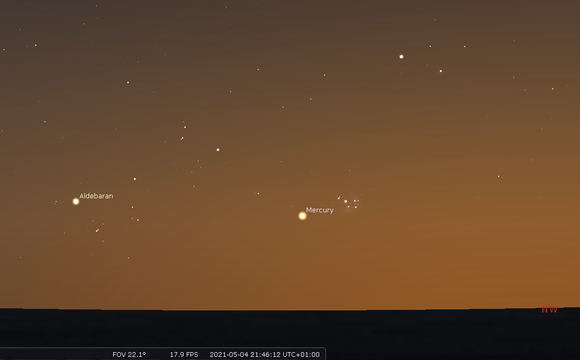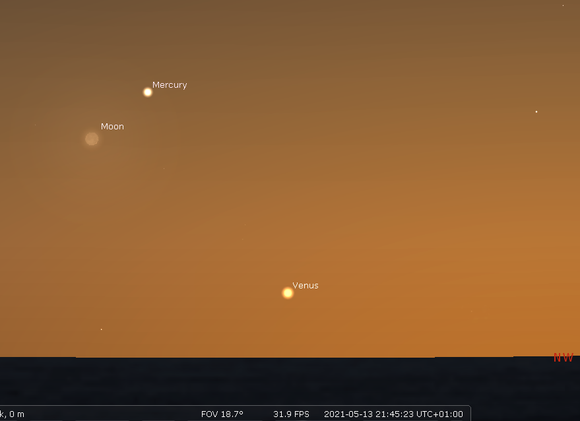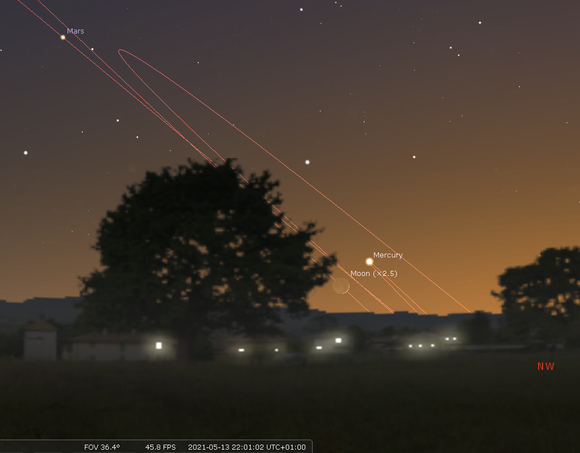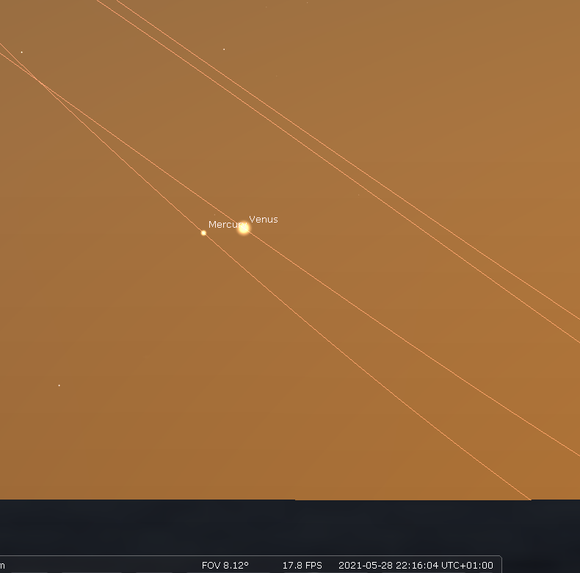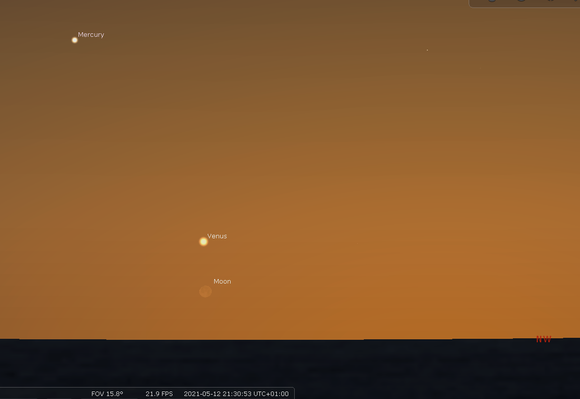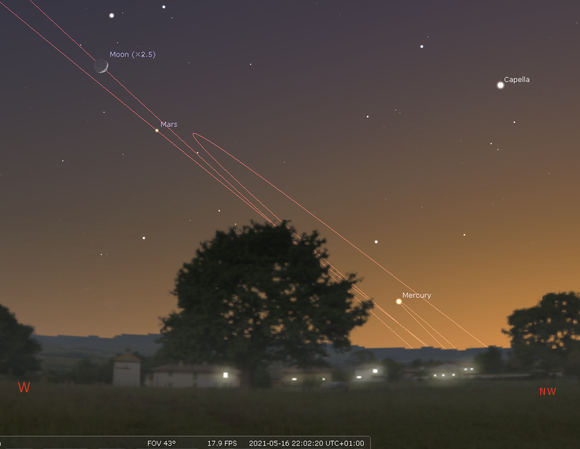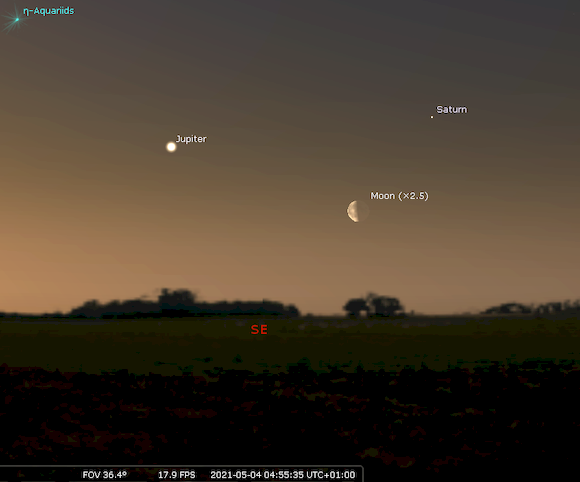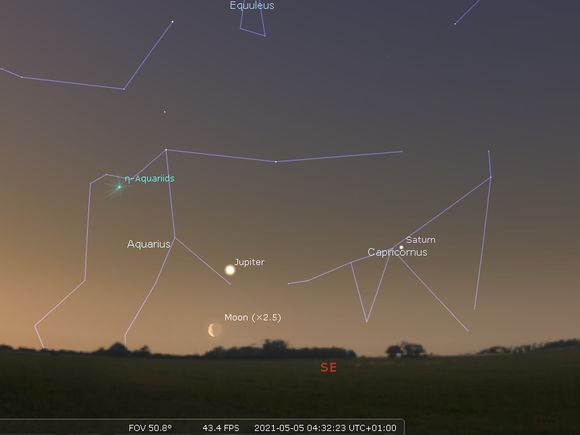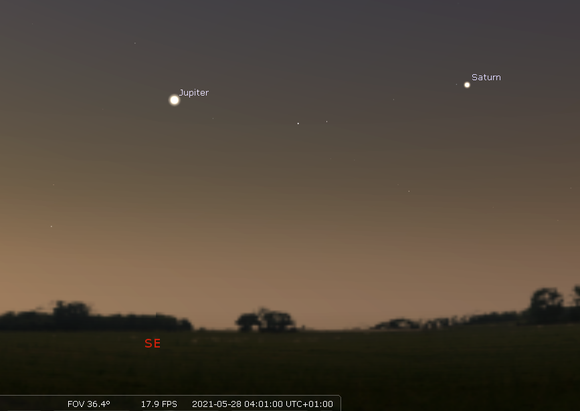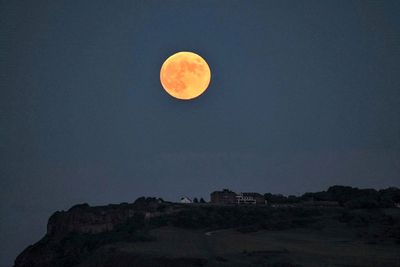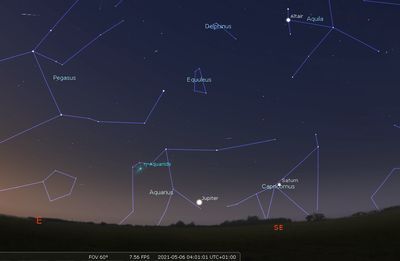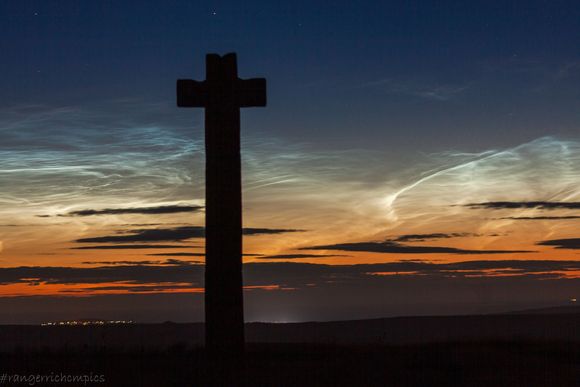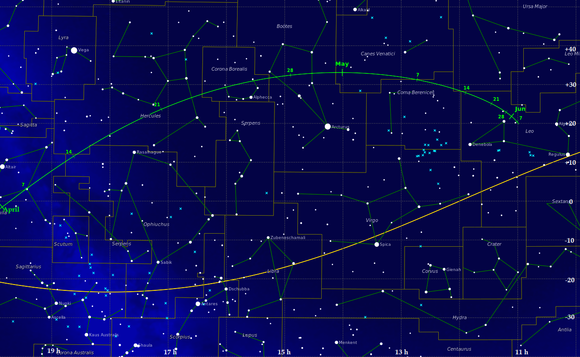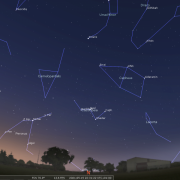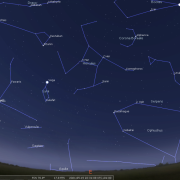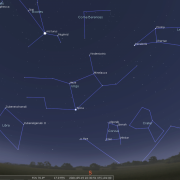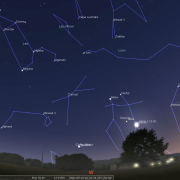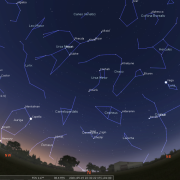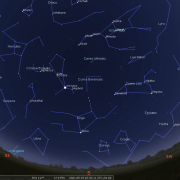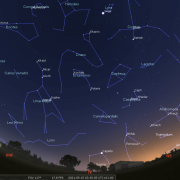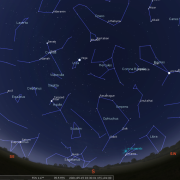In this month's Sky Notes:
- Planetary Skylights
- Meteors:Eta Aquarids
- Noctilucent cloud season
- Comet 2020 ATLAS R4
- May 2021 Sky Charts
Planetary Skylights - Brief
After a rather quiet April regarding planetary action, May offers up something more interesting for the observer, with both inferior planets visible low in the late evening twilight sky. The early dawn sky harbours the two largest planets; Jupiter and Saturn, but you will have to rise very early to spot them! The eta aquarid meteor shower peaks during the first week of the month, whilst the Noctilucent cloud season should start by the end of the May. Comet ATLAS R4 may also still be visible with binoculars or telescope. Finally, May also offers up yet another super moon event.
 We shall start with the inferior planets of Mercury and Venus. Mercury first, which is having its best evening showing this year. The elusive ‘messenger of the gods’ can already be located low in the WNW as the new month commences approximately 7 degrees above the horizon (a typical 7 x 50 binocular field). At magnitude -1.1, Mercury will be surprisingly bright, but this will gradually diminish as the month wears on. You will require a decent viewing aspect, free from taller trees or other obstructions to spot this shy world, which never strays far from the vicinity of the Sun in the sky. If possible, view on the 4th around 21:45 hrs BST, when Mercury sits to the left of the Pleiades star cluster, just above the WNW horizon.
We shall start with the inferior planets of Mercury and Venus. Mercury first, which is having its best evening showing this year. The elusive ‘messenger of the gods’ can already be located low in the WNW as the new month commences approximately 7 degrees above the horizon (a typical 7 x 50 binocular field). At magnitude -1.1, Mercury will be surprisingly bright, but this will gradually diminish as the month wears on. You will require a decent viewing aspect, free from taller trees or other obstructions to spot this shy world, which never strays far from the vicinity of the Sun in the sky. If possible, view on the 4th around 21:45 hrs BST, when Mercury sits to the left of the Pleiades star cluster, just above the WNW horizon.
View again around 21:15 BST on May 13th when a very slim crescent moon resides lower left of Mercury. Below them you may also spot bright Venus just above the NW horizon. By mid May Mercury reaches greatest elongation and will still be a respectable +0.3 mag object, brighter than the first magnitude star Capella, which resides just over a hand-span above Mercury (20 degrees). Mercury itself will then be almost 11 degrees in altitude above the horizon 40 minutes after sunset, the usual 'time slot' to look for Mercury. Mercury spends the remainder of the month slipping back towards the NW horizon, becoming less noticeable as it does so.
However, interest continues with Mercury being joined by brilliant Venus on the 28th which is slowly pulling away from the horizon. Mercury will have dimmed to mag +1.88 by then and may require the aid of binoculars to pull it out of the twilight. Both planets will lie just over 8 degrees above the NW horizon. If you fancy pointing a telescope at Mercury wait until 40 minutes after sunset. It is a small world, so don’t expect to see a great deal, but you may just discern a 54% phase and perhaps some subtle shading.
 Brilliant Venus edges up into the May twilight sky, visible below Mercury in the WNW until near the end of the month, when Mercury drops below it. Venus is located just a few degrees above the horizon and even by the month’s end is no more than 6 degrees. Venus is bright however and at magnitude -3.7 will cut through the light sky conditions in that direction and barring obscuring cloud, should be readily apparent to the naked eye. Wait half an hour after sunset before looking for Venus. On the 27/28th Venus is joined by departing Mercury, which will be a degree to the left of Venus and very much fainter. Because of the low altitude meaningful observations will be non existent, although you may discern the phase. If you really fancy a challenge, a day old crescent moon lies below Venus on the 12th, barely a couple of degrees above the horizon. View at 21:20 BST to stand the best chance of spotting it.
Brilliant Venus edges up into the May twilight sky, visible below Mercury in the WNW until near the end of the month, when Mercury drops below it. Venus is located just a few degrees above the horizon and even by the month’s end is no more than 6 degrees. Venus is bright however and at magnitude -3.7 will cut through the light sky conditions in that direction and barring obscuring cloud, should be readily apparent to the naked eye. Wait half an hour after sunset before looking for Venus. On the 27/28th Venus is joined by departing Mercury, which will be a degree to the left of Venus and very much fainter. Because of the low altitude meaningful observations will be non existent, although you may discern the phase. If you really fancy a challenge, a day old crescent moon lies below Venus on the 12th, barely a couple of degrees above the horizon. View at 21:20 BST to stand the best chance of spotting it.
 Mars, so long the sole evening planet, is located somewhat higher than Mercury and Venus, but is inexorably losing the race to stay afloat above the horizon. The red planet will be slowly tracking up through Gemini, below the 'twins' of Castor and Pollux. By late May Mars will have dimmed to mag + 1.72, fainter than nearby Pollux, both having a similar hue. The Martian disk now appears very small, not much more than a pale orange dot, so don’t expect to see Perseverance on the surface with a telescope! View on the 16th as twilight descends for a pleasing view of a crescent moon in earthshine above left of Mars. The inferior planets of Mercury and Venus will be more challenging to spot in the brighter twilight lower right.
Mars, so long the sole evening planet, is located somewhat higher than Mercury and Venus, but is inexorably losing the race to stay afloat above the horizon. The red planet will be slowly tracking up through Gemini, below the 'twins' of Castor and Pollux. By late May Mars will have dimmed to mag + 1.72, fainter than nearby Pollux, both having a similar hue. The Martian disk now appears very small, not much more than a pale orange dot, so don’t expect to see Perseverance on the surface with a telescope! View on the 16th as twilight descends for a pleasing view of a crescent moon in earthshine above left of Mars. The inferior planets of Mercury and Venus will be more challenging to spot in the brighter twilight lower right.
Dawn Planets
 If you are a very early riser (or cannot sleep), the two largest planets in our solar system; Jupiter and Saturn, dominate the dawn sky, dawn being around 4:00am by the end of May! Saturn is first to show in the SE around 03:30hrs BST at the start of May, visible amongst the stars of Capricorn and at mag + 0.7 its pearly white presence is relatively conspicuous. Not as conspicuous as Jupiter though, which follows Saturn up by just 15 minutes or so and at mag -2.3 far outshines Saturn, residing 15 degrees to the east and a tad lower. Both planets are still only 14 degrees above the horizon at the start of the month and therefore observations, other than with binoculars or the naked eye, will be compromised. View on the 4th and 5th when an old waning moon lies below left of Saturn (4th) and Jupiter the following morning.
If you are a very early riser (or cannot sleep), the two largest planets in our solar system; Jupiter and Saturn, dominate the dawn sky, dawn being around 4:00am by the end of May! Saturn is first to show in the SE around 03:30hrs BST at the start of May, visible amongst the stars of Capricorn and at mag + 0.7 its pearly white presence is relatively conspicuous. Not as conspicuous as Jupiter though, which follows Saturn up by just 15 minutes or so and at mag -2.3 far outshines Saturn, residing 15 degrees to the east and a tad lower. Both planets are still only 14 degrees above the horizon at the start of the month and therefore observations, other than with binoculars or the naked eye, will be compromised. View on the 4th and 5th when an old waning moon lies below left of Saturn (4th) and Jupiter the following morning.
 By the end of the month both Jupiter and Saturn will be rising not much after 01:30hrs BST and will have edged up to an almost respectable 20 degrees above the horizon. Telescopic observations will then become viable, admittedly in a limited time period from 03:00hrs. The tilt of Saturn's rings is closing up again with the North Pole tilted toward Earth by nearly 17 degrees. In the eyepiece Saturn remains a glorious sight, you may also note Titan, its largest moon as a speck nearby. Jupiter is perhaps more interesting to the observer, simply because the Jovian atmosphere and moon system is far more dynamic. The belts and banding across the disk is in continuous flux and early observations suggest that segments of the equatorial belt zone have recently taken on an intense orange colour. The fascination surrounding the size and hue of the great red spot is also high on the observer’s agenda when Jupiter returns to sky after being hidden by the Sun's glare. Finally, there is the daily dance of the Galilean moons, throwing up a different configuration each time it is viewed. Jupiter then is always worth a peek.
By the end of the month both Jupiter and Saturn will be rising not much after 01:30hrs BST and will have edged up to an almost respectable 20 degrees above the horizon. Telescopic observations will then become viable, admittedly in a limited time period from 03:00hrs. The tilt of Saturn's rings is closing up again with the North Pole tilted toward Earth by nearly 17 degrees. In the eyepiece Saturn remains a glorious sight, you may also note Titan, its largest moon as a speck nearby. Jupiter is perhaps more interesting to the observer, simply because the Jovian atmosphere and moon system is far more dynamic. The belts and banding across the disk is in continuous flux and early observations suggest that segments of the equatorial belt zone have recently taken on an intense orange colour. The fascination surrounding the size and hue of the great red spot is also high on the observer’s agenda when Jupiter returns to sky after being hidden by the Sun's glare. Finally, there is the daily dance of the Galilean moons, throwing up a different configuration each time it is viewed. Jupiter then is always worth a peek.
Finally, the Full Moon on May 26th is yet another super moon, being the middle of three consecutive super moon months. May's super moon will be nearest and so largest of the three. There is nothing special about the moon itself, it's not changing size, but is changing distance, thus, when a full moon occurs at, or close too, perigee (nearest to earth) in its orbit, it appears larger in the sky. At this particular full phase, the moon will be 357,311km (222,000km) distant from earth, 31,000 miles or 50,000 km closer than December's Full Moon, appearing over 13% larger to the eye than it did then. The moon will look impressive as it rises around 22:00hrs BST, and will continue to do so, arcing just 15 degrees above the south horizon, accentuating the size. Find a decent picturesque vantage point and go snap happy.

Should you are awake in the early hours of May 6th, keep an eye out for a few meteors in the predawn sky, when the Eta Aquarid meteor shower reaches a peak. The radiant of the shower lies close to eta Aquarius, one of the stars making up the "water jar" in the otherwise faint constellation of the Water Bearer. Aquarius is only just rising in the early morning hours at this time of year, which means the possible ZHR (zenith hourly rate) of 25-30 will never be achieved from UK shores. Realistically, an observer may spot around 15 meteors in a period from 02:45hrs - 04:00hrs. The Eta Aquarids is one of two meteor showers associated with debris particles deposited over time by comet Halley, the other shower being the Orionids seen in late October.
By the end of May Noctilucent Cloud activity normally commences. Noctilucent cloud is filamentary in structure, having a characteristic silvery-blue colour. It forms almost exclusively between latitudes 50 and 60 degrees north, high in the upper atmosphere-around 50 miles, five times higher than normal clouds. As twilight persists well into the night throughout late May, June and early July, this type of cloud formation can appear above the northern horizon long after sunset, often around midnight, shining quite distinctly. It is thought Noctilucent clouds form when water vapour condenses at the low temperatures that prevail at such altitudes onto particles suspended in the air, possibly pollutants from industrial sources, even aircraft. Do then keep a watch low to the north towards the month's end.
Comet 2020 ATLAS R4 appears to be visible in 70mm binoculars and telescopes only and has not really brightened as hoped. It is predicted to remain steady at magnitude +9 until early May, thereafter it will fade quite rapidly. Atlas R4 is a long period comet, returning every 934 years. Having safely passed the Sun at the start of March at a distance of 95 million miles, or 1.03 astronomical units (AU), ATLAS R4's closest approach to Earth came on April 23rd, becoming an evening object in the constellation of Bootes. The comet is heading toward the Bootes-Canes Venatici border and will spend the first week of May passing through the Hunting Dogs. If you want to hunt R4 down it will become visible from 22:30hrs in the SE reaching a maximum altitude of almost 69 degrees above the south horizon by midnight. The comet passes below the Whale galaxy (NGC 4631) on May 7th. You will require a tracked imaging device to capture any detail of the comet.
Chart for Comet ATLAS R4 April-June. (click for larger image)
Chart credit Dominic Ford
May 2021 Sky Charts
Additional Image Credits:
- Planets and Comets where not otherwise mentioned: NASA
- Sky Charts: Stellarium Software and Starry Night Pro Plus 8.
- Log in to post comments

